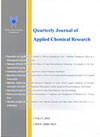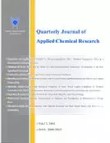فهرست مطالب

Journal of Applied Chemical Research
Volume:13 Issue: 3, Summer 2019
- تاریخ انتشار: 1398/04/10
- تعداد عناوین: 8
-
-
Pages 8-19In this research, a highly sensitive, selective, rapid and simple micro-funnel magnetic stirringassisted liquid–liquid microextraction (MF-MSA-LLME) method combined with flame atomic absorption spectrometry (FAAS) was introduced for the preconcentration, extraction, and measurement of trace amounts of silver ion. In this method 1-(2–Pyridylazo)-2-naphthol (PAN) and 1-octanol were used as chelating agent and extraction solvent. Effective parameters on extraction efficiency such as pH of sample solution, type and volume of extraction solvent, amount of ligand, extraction time, and ion strength were investigated and optimized. Under the optimum conditions, calibration curve was linear in the range of 2-250 μg L-1 with correlation of coefficient r2=0.997. Detection limit, relative standard deviation and the enrichment factor were 0.251 μg L-1, 4% (n=7,C=80 μg L-1) and 135, respectively. The proposed procedure was successfully applied for the preconcentration and determination of trace amount of silver in water samples with good accuracy and good validity.Keywords: Micro-funnel magnetic stirring, Assisted liquid–liquid microextraction, Silver, Flame atomic absorption spectrometry, Water samples
-
Pages 20-27New coordination polymer of [HgLCl2]n (1) with HgCl2 and Schiff base bidentate ligand (4-methoxyphenyl) pyridine-2yl methyleneamine (L) was prepared and structurally characterized. In the 1D network structure of 1, the mecury (II) ion adopts an HgN2Cl3 distorted square pyramid geometry. In this complex, one of the chlorine acts as bridging ligand connecting two adjacent mercury(II) ions while, the L ligand is coordinated to mercury(II)ion in a cyclic-bidentate fashion forming an five-membered metallocyclic ring. Coordination compounds1 has been characterized by infrared spectroscopy, UV-visible spectroscopy, elemental analyses and single-crystal X-ray diffraction. The compound crystallizes in the monoclinic space group P 21/c with a = 9.3053(17), b = 7.1125(13), c = 20.708(4), and β = 80.208(4)°. The antibacterial activities of the complex, ligand and metal salt were tested against Gram-positive bacteria Staphylococcus aureus and Gramnegativebacteria Escherichia coli studied by disk diffusion method.Keywords: Coordination polymers, Mercury (II) compounds, Nitrogen-donor ligands, Schiff bases, Crystal structure, Antibacterial activities
-
Pages 27-40A green and efficient one-pot three component reaction of 4-hydroxycoumarin or 1,3-dimethylbarbutyric acid, aryl glyoxals and amides (thioacetamide) has been developed in the presence of BF3- SiO2 nanoparticles in water. This method has several advantages such as high to excellent product yields in short reaction time, atom economy, environment friendly, reusable catalyst and no need for chromatographic separations.Keywords: Multi-component reactions, BF3- SiO2 NPs, One-pot, Aryl glyoxal, 4-hydroxycoumarin
-
Pages 41-50To investigate template effect on physicochemical properties of zeolite and enhance the molecular sieving properties, adsorption of methionine amino acid was studied by spectroscopic methods. Four zeolites such as methionine templated analcime, methionine templated zeolite P, N, N-dibenzyl N,N,N,N-tetramethylethylenediamine (DBTMED) templated analcime and free template analcime were synthesized as adsorbents and characterized with scanning electron microscopy (SEM), Fourier transformation infrared spectroscopy (FTIR) and N2 adsorptiondesorption analyses. The influence of methionine concentration and pH on the adsorption ability of zeolites was examined; furthermore, the adsorption isotherms of methionine on zeolites were studied and the experimental data were fitted with Freundlich and Langmuir equations in order to obtain sorption parameters.The results indicated that the adsorption of amino acid was not only depended on zeolites surface areas but also on their pore size. The existence of template in zeolite synthesis could help enlarging the pore size and enhancing the adsorption ability.Keywords: Analcime zeolite, Zeolite-P, Methionine adsorption, Template assisted method
-
Pages 51-65In this paper, CuO nanoparticles are synthesized using Tilia platyphyllos extract as reducing and stabilizing agents and TiO2are prepared via facile sol-gel method as an ideal support. FT-IR spectroscopy, UV-Vis spectroscopy, X-ray Diffraction (XRD), Scanning Electron Microscopy (FESEM), Energy Dispersive X-ray Spectroscopy (EDS), and Transmission Electron Microscopy (TEM) were used to characterize TiO2, CuONPs, and CuO/ TiO2 nanocomposite. The catalytic activity of the CuO/ TiO2 nanocomposite was investigated for the reduction of Methyl Orange (MO), and Methylene Blue (MB) at room temperature. CuO/ TiO2 nanocomposite can was found to be a highly active catalyst. In addition, it was found that CuO/ TiO2 nanocomposite can berecovered and reused several times without significant loss for its catalytic activity.Keywords: TiO2, CuO, TiO2 nanocomposite, Tilia platyphyllos, NaBH4, Organic dyes
-
Pages 66-79Carbon paste electrode modified with cobalt impregnated zeolite was prepared by mixing of cobalt_zeolite (Co_Z) and graphite powder with different percent. The electrochemical oxidation of cefixime at such electrodes was investigated using the cyclic voltammetric and amperometric techniques. It is not electrochemically active towards cefixime oxidation in 0.1 M phosphate buffer solution (pH=7) on a carbon paste electrode modified with zeolite. The presence of cobalt ions in the zeolite matrix, by soaking the electrode in an aqueous Co(NO3)2 solution, markedly enhances the electrocatalytic activity which was found to depend on the cobalt content. However, the electrocatalytic activity depends on different percent of Co_Z. Under the selected conditions, the anodic peak current was linearly dependent on the concentration of cefixime in the range 0.003–8 mM with the cyclic voltammetric method. The detection limit (S/N=3) was also estimated to be 2.98 μM. Finally, this method was applied for the determination of cefixime in tablet samples.Keywords: Cefixime, Cobalt, Electrocatalytic oxidation, Modified electrode, Zeolite
-
Pages 80-86A three-component reaction between 1,2-phenylenediamine, ferrocenecarbaldehyde, and isocyanides in the presence of a catalytic amount of p-toluenesulfonic acid for the synthesis of 3,4-dihydroquinoxalin-2-amine derivatives containing a ferrocene unit is reported. This approach is an effective procedure because the products have a broad spectrum of biological and pharmacological activities such as insecticide, fungicide, herbicide, anthelmintic, antibacterial, antimycobacterial, antiprotozoal, anticancer and antibiotic properties.Keywords: Multicomponent reaction, Ferrocene carbaldehyde, Quinoxaline, p-Toluenesulfonic acid
-
Pages 87-96TiO2-grafted cellulose bio-nanocomposite (Cell.Com) was successfully prepared by combining modified cellulose and TiO2 nanoparticles via copper-catalyzed alkyne-azide click reaction. The antibacterial and cytotoxicity effects of Cell.Com containing cellulose, triazole ring and TiO2 moieties are reported in this work. The antibacterial activity of Cell.Com was investigated against gram positive (S. aureus and B. subtilis) and gram negative (E. coli and P. aeruginosa) bacteria. The antibacterial results indicate that the Cell.Com exhibits a wide range of antibacterial activity against both gram positive and gram negative bacteria which is due to the presence of TiO2 and triazole ring moieties in its structure. In addition, the cytotoxicity effect of Cell.Com was studied in vitro on cervical cancer (HeLa), breast carcinoma (MCF-7), sarcoma osteogenic (Saos) and fibroblast cells by MTT assay. The cell viability results show that the Cell. Com diminishes relatively cancer cells growth in a dosage and time dependent way probably through triazole moiety, while no apparentcytotoxicity effect is observed on the normal fibroblast cells.Keywords: Nanocomposite, Cellulose, TiO2, Antibacterial, Cytotoxicity


